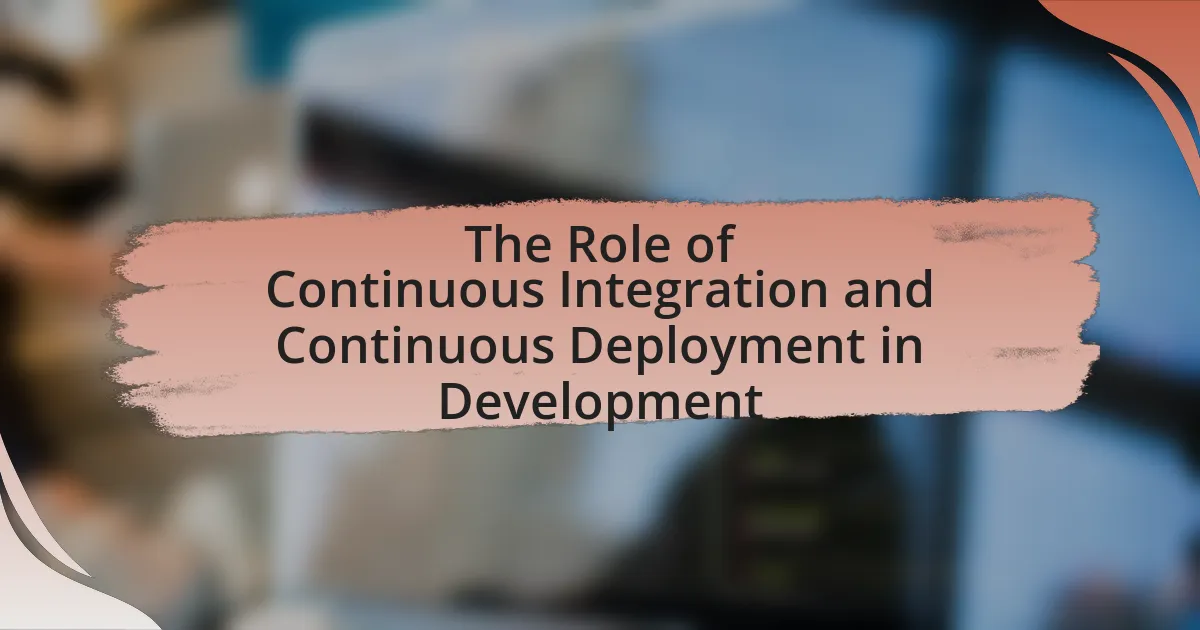Continuous Integration (CI) and Continuous Deployment (CD) are essential software development practices that enhance code quality and accelerate delivery. CI involves frequent integration of code changes into a shared repository, supported by automated testing to identify issues early, while CD automates the deployment of validated code to production. This article explores the principles, importance, and best practices of CI/CD, addressing challenges in the development process and highlighting strategies for effective implementation. Key metrics for measuring success, such as deployment frequency and lead time, are also discussed, providing insights into how these practices improve software quality and delivery speed.

What is Continuous Integration and Continuous Deployment?
Continuous Integration (CI) is a software development practice where developers frequently integrate their code changes into a shared repository, followed by automated builds and tests. Continuous Deployment (CD) extends this practice by automatically deploying every code change that passes the automated tests to production, ensuring that software is always in a releasable state. This approach reduces integration problems, improves software quality, and accelerates the release of new features, as evidenced by studies showing that teams practicing CI/CD can release updates up to 30 times more frequently than those that do not.
How do Continuous Integration and Continuous Deployment work together?
Continuous Integration (CI) and Continuous Deployment (CD) work together by streamlining the software development process, ensuring that code changes are automatically tested and deployed. CI involves the frequent integration of code changes into a shared repository, where automated tests verify the integrity of the code. This process allows developers to identify and fix issues early, reducing integration problems. CD takes this a step further by automatically deploying the validated code to production environments, enabling faster delivery of features and updates to users. The synergy between CI and CD enhances development efficiency, minimizes manual intervention, and supports a rapid feedback loop, ultimately leading to higher software quality and quicker time-to-market.
What are the key principles of Continuous Integration?
The key principles of Continuous Integration (CI) include frequent code integration, automated testing, and immediate feedback. Frequent code integration ensures that developers merge their changes into a shared repository multiple times a day, which minimizes integration issues. Automated testing involves running tests automatically on each integration to detect errors early, enhancing code quality. Immediate feedback allows developers to receive prompt notifications about the success or failure of their builds, enabling quick resolution of issues. These principles collectively facilitate a smoother development process and improve collaboration among team members.
What are the key principles of Continuous Deployment?
The key principles of Continuous Deployment include automation, rapid feedback, and incremental changes. Automation ensures that the deployment process is streamlined, reducing human error and increasing efficiency. Rapid feedback allows teams to quickly identify issues and make necessary adjustments, fostering a culture of continuous improvement. Incremental changes involve deploying small, manageable updates rather than large releases, which minimizes risk and simplifies troubleshooting. These principles are supported by practices such as automated testing and monitoring, which help maintain software quality and performance throughout the deployment process.
Why are Continuous Integration and Continuous Deployment important in software development?
Continuous Integration (CI) and Continuous Deployment (CD) are crucial in software development because they enhance code quality and accelerate delivery. CI allows developers to integrate code changes frequently, which leads to early detection of errors and reduces integration problems. According to a study by Duvall et al. in “Continuous Integration: Improving Software Quality and Reducing Risk,” teams practicing CI can identify issues within minutes rather than days, significantly improving overall productivity. CD further automates the release process, enabling teams to deploy code changes to production quickly and reliably. This rapid deployment capability is supported by research from the 2021 State of DevOps Report, which indicates that high-performing teams that implement CD can deploy code 46 times more frequently than their lower-performing counterparts, leading to faster feedback and improved customer satisfaction.
What challenges do they address in the development process?
Continuous Integration (CI) and Continuous Deployment (CD) address several challenges in the development process, primarily focusing on integration issues, deployment frequency, and quality assurance. CI helps mitigate integration challenges by allowing developers to merge code changes frequently, which reduces integration problems and ensures that new code is tested against the existing codebase regularly. CD further addresses deployment frequency by automating the release process, enabling teams to deploy updates quickly and reliably, thus reducing the time between development and production. Additionally, both CI and CD enhance quality assurance by incorporating automated testing, which identifies bugs early in the development cycle, leading to higher software quality and reduced costs associated with fixing issues later in the process.
How do they improve software quality and delivery speed?
Continuous Integration (CI) and Continuous Deployment (CD) improve software quality and delivery speed by automating the integration and deployment processes, which reduces manual errors and accelerates feedback loops. CI enables developers to frequently merge code changes into a shared repository, where automated tests are run to identify issues early, leading to higher code quality. CD further streamlines this by automatically deploying code to production after passing tests, ensuring that new features and fixes reach users quickly. According to a study by DORA (DevOps Research and Assessment), organizations that implement CI/CD practices can achieve 46 times more frequent deployments and 96 times faster recovery from failures, demonstrating a clear link between these practices and enhanced software quality and delivery speed.

What are the best practices for implementing Continuous Integration and Continuous Deployment?
The best practices for implementing Continuous Integration (CI) and Continuous Deployment (CD) include maintaining a single source repository, automating the build process, and ensuring automated testing. Maintaining a single source repository allows all team members to access the latest code, which reduces integration issues. Automating the build process ensures that code changes are compiled and packaged consistently, minimizing human error. Automated testing verifies that new code does not break existing functionality, which is crucial for maintaining software quality. According to a study by Duvall et al. in “Continuous Integration: Improving Software Quality and Reducing Risk,” organizations that implement these practices experience a significant reduction in integration problems and deployment failures, leading to faster delivery cycles and improved software reliability.
How can teams effectively adopt Continuous Integration?
Teams can effectively adopt Continuous Integration (CI) by implementing automated testing and version control practices. By integrating code changes into a shared repository frequently, teams can detect errors quickly and improve software quality. Research indicates that organizations using CI practices experience a 30% reduction in integration issues, as reported in the “State of DevOps Report 2021” by Puppet. Additionally, establishing a CI pipeline that includes automated builds and tests ensures that code is validated consistently, leading to faster feedback loops and more efficient development cycles.
What tools are essential for successful Continuous Integration?
Essential tools for successful Continuous Integration include version control systems, build automation tools, and continuous integration servers. Version control systems like Git enable teams to manage code changes efficiently, while build automation tools such as Maven or Gradle streamline the process of compiling and packaging code. Continuous integration servers like Jenkins or CircleCI automate the testing and deployment processes, ensuring that code changes are integrated and validated regularly. These tools collectively enhance collaboration, reduce integration issues, and improve software quality by facilitating frequent code integration and testing.
How can teams ensure code quality during Continuous Integration?
Teams can ensure code quality during Continuous Integration by implementing automated testing, code reviews, and continuous monitoring. Automated testing allows teams to run unit tests, integration tests, and end-to-end tests automatically with each code commit, ensuring that new changes do not introduce bugs. Code reviews facilitate peer evaluation of code changes, promoting adherence to coding standards and best practices. Continuous monitoring of the codebase helps identify performance issues and code smells early in the development process. According to a study by the University of Alberta, teams that adopt these practices experience a 30% reduction in defects, demonstrating the effectiveness of these strategies in maintaining high code quality during Continuous Integration.
What strategies enhance Continuous Deployment practices?
Implementing automated testing is a key strategy that enhances Continuous Deployment practices. Automated testing ensures that code changes are validated quickly and accurately, reducing the risk of introducing bugs into production. According to a study by Google, teams that utilize automated testing can deploy code 30 times more frequently than those that do not, demonstrating a clear correlation between testing automation and deployment frequency. Additionally, adopting feature toggles allows teams to deploy incomplete features safely, enabling gradual rollouts and minimizing the impact of potential issues. Furthermore, maintaining a robust monitoring system post-deployment helps teams quickly identify and address any problems that arise, ensuring system reliability and user satisfaction.
How can automated testing be integrated into Continuous Deployment?
Automated testing can be integrated into Continuous Deployment by incorporating automated test suites that run during the deployment pipeline. This integration ensures that code changes are validated against predefined test cases before they are deployed to production. Continuous Integration tools, such as Jenkins or CircleCI, can be configured to trigger automated tests whenever new code is pushed to the repository. According to a study by the DevOps Research and Assessment (DORA) team, organizations that implement automated testing within their Continuous Deployment processes experience 30 times more frequent deployments and 60 times lower change failure rates, demonstrating the effectiveness of this integration.
What role does monitoring play in Continuous Deployment?
Monitoring plays a critical role in Continuous Deployment by ensuring the stability and performance of applications after each deployment. It allows teams to track application health, detect anomalies, and respond to issues in real-time, thereby minimizing downtime and enhancing user experience. Effective monitoring tools provide metrics and alerts that inform developers about the impact of new code changes, enabling quick rollbacks if necessary. According to a 2021 report by the DevOps Research and Assessment (DORA), organizations that implement robust monitoring practices experience 50% fewer failures in production, highlighting the importance of monitoring in maintaining deployment quality.

What are the common pitfalls in Continuous Integration and Continuous Deployment?
Common pitfalls in Continuous Integration (CI) and Continuous Deployment (CD) include inadequate testing, lack of automation, and poor communication among team members. Inadequate testing can lead to undetected bugs being deployed, which negatively impacts software quality. Lack of automation in the CI/CD pipeline can result in manual errors and slow deployment processes, hindering efficiency. Poor communication can cause misunderstandings about deployment schedules and requirements, leading to integration issues. These pitfalls are frequently observed in organizations that do not prioritize robust CI/CD practices, as highlighted in industry reports that emphasize the importance of comprehensive testing and effective team collaboration for successful CI/CD implementation.
What mistakes should teams avoid during implementation?
Teams should avoid inadequate planning during implementation. Insufficient planning can lead to misalignment of goals, unclear roles, and missed deadlines. For instance, a study by the Project Management Institute found that 39% of projects fail due to a lack of proper planning. Additionally, teams should not neglect communication, as poor communication can result in misunderstandings and errors. According to a report by the International Journal of Project Management, effective communication is crucial for project success, with 90% of successful projects citing strong communication as a key factor. Lastly, teams must avoid skipping testing phases, as this can lead to undetected bugs and issues in the final product, ultimately affecting user satisfaction and project viability.
How can lack of communication impact Continuous Integration and Deployment?
Lack of communication can severely hinder Continuous Integration and Deployment (CI/CD) by leading to misunderstandings, misaligned goals, and integration failures. When team members do not effectively share information regarding code changes, deployment schedules, or testing results, it can result in conflicts in the codebase, delayed releases, and increased technical debt. For instance, a study by the Project Management Institute found that poor communication is a primary factor in project failure, with 57% of project failures attributed to ineffective communication. This statistic underscores the critical need for clear communication channels in CI/CD processes to ensure that all team members are aligned and informed, ultimately facilitating smoother integrations and deployments.
What are the risks of inadequate testing in Continuous Deployment?
Inadequate testing in Continuous Deployment poses significant risks, including the introduction of critical bugs into production environments. These bugs can lead to system outages, negatively impacting user experience and potentially resulting in financial losses. For instance, a study by the Ponemon Institute found that the average cost of a data breach is $3.86 million, highlighting the financial implications of insufficient testing. Additionally, inadequate testing can compromise security, exposing applications to vulnerabilities that malicious actors can exploit. According to a report from Veracode, 83% of applications contain at least one vulnerability, underscoring the importance of thorough testing to mitigate such risks. Furthermore, the lack of proper testing can erode customer trust and brand reputation, as users may experience unreliable software. Therefore, the risks associated with inadequate testing in Continuous Deployment are substantial and can have far-reaching consequences for organizations.
What are the key metrics to measure the success of Continuous Integration and Continuous Deployment?
The key metrics to measure the success of Continuous Integration (CI) and Continuous Deployment (CD) include deployment frequency, lead time for changes, change failure rate, and mean time to recovery (MTTR). Deployment frequency indicates how often new code is deployed to production, reflecting the team’s ability to deliver updates rapidly. Lead time for changes measures the time taken from code commit to deployment, showcasing efficiency in the development process. Change failure rate quantifies the percentage of deployments that result in failures, providing insight into the stability and quality of releases. Finally, MTTR assesses the average time taken to recover from a failure in production, highlighting the team’s responsiveness to issues. These metrics collectively provide a comprehensive view of the effectiveness and reliability of CI/CD practices.
How can deployment frequency indicate success?
Deployment frequency indicates success by reflecting the efficiency and effectiveness of a development team’s processes. High deployment frequency suggests that a team can deliver features, fixes, and improvements rapidly, which is often associated with agile methodologies and a strong DevOps culture. For instance, organizations that deploy multiple times a day, like Amazon, have reported increased customer satisfaction and faster time-to-market, demonstrating that frequent deployments correlate with business agility and responsiveness to user needs. This relationship is supported by the 2021 State of DevOps Report, which found that high-performing teams deploy 208 times more frequently than low performers, highlighting the direct link between deployment frequency and overall success in software delivery.
What role does lead time play in assessing effectiveness?
Lead time is a critical metric in assessing effectiveness as it measures the duration from the initiation of a task to its completion. In the context of Continuous Integration and Continuous Deployment (CI/CD), shorter lead times indicate a more efficient development process, allowing teams to deliver features and fixes to users more rapidly. Research shows that organizations with optimized lead times can achieve up to 30% faster delivery rates, enhancing overall productivity and responsiveness to market demands. This correlation between lead time and effectiveness underscores the importance of minimizing delays in the development pipeline to improve software quality and user satisfaction.
What practical tips can enhance Continuous Integration and Continuous Deployment efforts?
Implementing automated testing is a practical tip that can significantly enhance Continuous Integration (CI) and Continuous Deployment (CD) efforts. Automated testing ensures that code changes are validated quickly and accurately, reducing the likelihood of bugs in production. According to a study by the National Institute of Standards and Technology, automated testing can decrease the cost of software development by up to 30% by identifying issues early in the development cycle. Additionally, maintaining a robust CI/CD pipeline with clear version control practices allows teams to track changes effectively and roll back if necessary, further streamlining the deployment process.

Leave a Reply